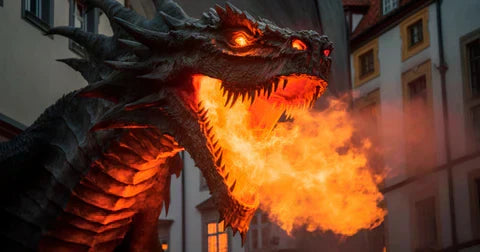Kids are fascinated by dragons for many reasons, mixing fantasy, power, and a hint of the unknown. Dragons are purely imaginary, letting children explore possibilities beyond their everyday lives, which sparks creativity and wonder. Unlike the real world, dragons often ignore rules and logic. They fly wherever they wish, guard treasure, and answer to no one. This feeling of complete freedom and control can be incredibly liberating for kids, giving them an escape from their own limitations. Because children are so captivated by these mythical creatures, learning dragon facts is incredibly engaging for them.

Fascinating Dragon Information Kids Will Love
Dragons captivate kids with a powerful and lasting allure, mixing fantasy, strength, and a variety of cultural meanings. Because dragons exist only in stories and myths, children's imaginations can run wild. They can be any size, color, or have any power, making them perfectly suited for a child's unique fantasy world. Almost all depictions of dragons show them as incredibly strong creatures. Their immense power, whether it's breathing fire, flying, their massive size, or magical abilities, is simply mesmerizing. Many dragon tales feature brave knights or heroes facing a terrifying beast to protect others or claim a treasure. These stories teach children about courage, perseverance, and how good can triumph over evil. Kids who are enamored with fiery beasts will enjoy reading a wide variety of children's dragon books all about these magnificent creatures. Here are some cool dragon facts about fire-breathing creatures that we think your kids will find interesting.
Fiery Dragon Facts Fuel the Imagination
Dragons are incredibly adaptable creatures. They can be good or evil, tiny or enormous, and breathe fire or ice. Plus, they can live just about anywhere—in mountains, caves, or even underwater. Because there are so few strict rules about them, kids can easily invent their own dragon stories, personalities, and entire worlds. Learning about dragons opens a door to vast fantasy realms, offering an exciting escape from everyday life and a space where anything feels possible. This really boosts imaginative play, which is super important for developing a child's thinking, social, and emotional skills. Kids can literally "give wings" to their thoughts. Dragons also have amazing powers like flight, fire-breathing, incredible strength, and often ancient wisdom or magic. These powerful traits are naturally fascinating to children as they start exploring their own sense of capability and control. Continue reading to uncover some of the most fascinating facts about dragons.

(1) Dragonologist is the scientific name of a person who studies dragons.
There is no specific certification or training required to earn this title. It simply refers to anyone who devotes time to gaining knowledge about dragons. Most dragonologists are curious students who wish dragons well, while some dark dragonologists want harm to befall upon the magical beasts.
(2) Not all dragons breathe fire.
Even though we often picture dragons as fiery beasts, many cultures around the world imagine them quite differently. For instance, Eastern dragons (like those in Chinese and Japanese traditions) are frequently linked to water, clouds, rain, and good fortune. They're usually seen as benevolent symbols of power and wisdom, and you'll often find them depicted without wings and, notably, they don't breathe fire. Instead, they might command storms, cause floods, or bring life-giving rain. It's not just Eastern myths either; even in Western lore, some dragons breathe things other than flames. You might encounter tales of dragons that exhale ice, poison, smoke, lightning, or even sand.
(3) The dragon has a lot of symbolism in China.
he powerful mystical animal represents the emperor, the most powerful leadership position that reigned over China for 2000 years. Dragons are also considered benevolent symbols that produce rain during droughts. They also represent nobility, luck, and benevolence. As a preeminent symbol for the Chinese New Year, they appear as decorations in Chinese festivals, marching in parades, and as statues throughout the country.

(4) A dragonet is a small dragon.
Many people assume a "dragonet" is a baby dragon, but that's not quite right. A dragonet describes a small dragon, similar to how a pony is a smaller type of horse, rather than a juvenile one. Measuring at about four feet long, these tiny mythological creatures are incredibly fierce and hostile. There were believed to have unique, magical powers in addition to breathing fire, and possess a higher intelligence than their larger peers.
(5) Hatchling is the name for a baby dragon.
Like many reptiles and birds, baby dragons, known as hatchlings, typically emerge from eggs. These tiny dragons are often portrayed as quite capable right from the start. Shortly after hatching, they might be able to walk, use early versions of their elemental breath (like a tiny puff of smoke or a small spark), and even fly short distances. A hatchling's growth rate can vary wildly depending on the fantasy world. Some might grow incredibly quickly, reaching impressive sizes in just months or years, while others could have extremely long maturation periods, taking centuries to become full-grown adults.

(6) Smaug is considered one of the most famous dragons in literature.
As the main antagonist in J.R.R. Tolkien's The Hobbit, Smaug is a hoarder who refuses to share his accumulated resources with others. He is considered a powerful and fearsome dragon who has a history of invading kingdoms. Smaug plays a big role in Lord of the Rings, which picks up about 60 years after the end of The Hobbit.
(7) Toothless from "How to Train Your Dragon" is the most popular new dragon character.
Toothless is the last known Night Fury, a dragon species once dramatically called "the unholy offspring of lightning and death itself." He has sleek black scales with lighter spots on his sides, giving him the appearance of a manta ray or a black panther. Notably, he possesses two sets of wings: a large main pair and a smaller pair closer to his tail. His name, of course, comes from his distinctive retractable teeth. A pivotal part of his story is the loss of his left tail fin, an injury he sustained when Hiccup shot him down. This meant he couldn't fly on his own, a challenge that ultimately led to Hiccup designing and building his famous prosthetic tail fin.

(8) Elliott is the most well-known, friendly dragon who appeared in Pete's Dragon.
A Disney movie originally released in 1977, Elliott became an instant hero. As an invisible best friend and guardian to a little boy fleeing an abusive home, Elliott is a loving, constant companion and source of strength for Pete. Elliott is best known as a benevolent guardian of children, particularly those in need, such as the orphaned boy Pete. One of Elliott's most important abilities is his power to turn invisible, which lets him blend seamlessly into his surroundings. He can also fly, soaring high above the clouds, and breathe fire. Despite these impressive powers, Elliott is often depicted as somewhat clumsy. This can lead to funny situations or even accidental property damage, for which Pete might initially take the blame when Elliott is invisible.

(9) There is only one sort-of real dragon.
Everyone knows that dragons don't really exist. They have been brought to life in myths, legends, movies and books, but there were never actually fire-breathing creatures that roamed the earth. However, there is a type of lizard called a Komodo dragon that resembles the mythical beasts. These giant lizards grow to more than 2.5 meters long and live in the Indonesian forests. While they don't breathe fire, their bite is poisonous.
10) Dragons can live for centuries.
Dragons are renowned for their incredibly long lives, often spanning centuries or even millennia in mythology and fantasy. They're almost universally recognized as among the longest-living creatures in any fictional realm. Most commonly, dragons live for hundreds to thousands of years. Many fantasy systems outline distinct life stages, from "wyrmling" to "ancient" and "great wyrm," with these later stages lasting for centuries or more. For instance, some lore suggests dragons can remain in good health for over 1,200 years.
(11) Dragons don't die from old age.
Interestingly, many tales imply that dragons don't simply die due to their bodies failing from old age like humans do. Instead, they often continue to grow and age indefinitely until they are defeated by an outside force, such as a hero, another dragon, or a natural disaster. A natural death might only occur if their immense power or size becomes too much for their bodies to contain, or if they choose to undergo a specific ritual.
(12) Ancient people believed dinosaur fossils were dragon bones.
It's a popular and intriguing idea that ancient people sometimes interpreted dinosaur fossils as the remains of dragons or other mythical creatures. There's solid evidence and scholarly discussion backing this theory. Many dinosaurs, especially large predators, have skeletal structures that visually resemble the scaled, reptilian, and often fearsome imagery of dragons found in various myths. Imagine finding a long, powerful tail, sharp teeth, and massive limb bones; it would be easy for someone to piece those together in their mind to form a dragon-like creature. Interestingly, regions rich in certain dinosaur fossils often also have strong, long-standing dragon myths.
(13) Dragon blood has magical properties.
Dragon blood is almost universally believed to possess powerful magical properties. While these properties vary depending on the specific lore, they are consistently significant and often dangerous. Frequently, dragon blood is depicted as a potent healing agent, capable of curing diseases, mending wounds, and even extending life—a trait that aligns with dragons' immense vitality and long lifespans. However, there's a darker side: the blood of certain dragons can be highly corrosive, acidic, or venomous. Some tales describe it as so poisonous that it can wither plants or even burn through metal and stone. Occasionally, contact with dragon blood can even grant glimpses into the future or provide enhanced perceptive abilities.




